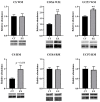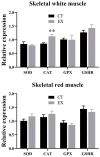Improving the Aerobic Capacity in Fingerlings of European Sea Bass (Dicentrarchus labrax) through Moderate and Sustained Exercise: A Metabolic Approach
- PMID: 38254443
- PMCID: PMC10812480
- DOI: 10.3390/ani14020274
Improving the Aerobic Capacity in Fingerlings of European Sea Bass (Dicentrarchus labrax) through Moderate and Sustained Exercise: A Metabolic Approach
Abstract
Sustained swimming induces beneficial effects on growth and energy metabolism in some fish species. However, the absence of a standardized exercise regimen that guarantees an optimal response to physical activity is due to the anatomical, behavioral, and physiological differences among species, and the different conditions of tests applied, which are especially notable for the early stages of cultured species. The objective of this study was to assess the growth and metabolic responses of European sea bass submitted to continuous and moderate exercise exposure, selecting a practical swimming speed from swimming tests of groups of five fingerlings. The exercise-effects trial was carried out with 600 sea bass fingerlings (3-5 g body weight) distributed in two groups (control: voluntary swimming; exercised: under sustained swimming at 1.5 body lengths·s-1). After 6 weeks, growth parameters and proximal composition of both muscles were not altered by sustained swimming, but an increased synthetic capacity (increased RNA/DNA ratio) and more efficient use of proteins (decreased ΔN15) were observed in white muscle. The gene expression of mitochondrial proteins in white and red muscle was not affected by exercise, except for ucp3, which increased. The increase of UCP3 and Cox4 protein expression, as well as the higher COX/CS ratio of enzyme activity in white muscle, pointed out an enhanced oxidative capacity in this tissue during sustained swimming. In the protein expression of red muscle, only CS increased. All these metabolic adaptations to sustained exercise were also reflected in an enhanced maximum metabolic rate (MMR) with higher aerobic scope (AMS) of exercised fish in comparison to the non-trained fish, during a swimming test. These results demonstrated that moderate sustained swimming applied to sea bass fingerlings can improve the physical fitness of individuals through the enhancement of their aerobic capacities.
Keywords: aerobic scope; mitochondrial proteins; muscles; nitrogen fractionation; sea bass; sustained swimming.
Conflict of interest statement
The authors declare no conflicts of interest.
Figures






Similar articles
-
An investigation of metabolic prioritization in the European sea bass, Dicentrarchus labrax.Physiol Biochem Zool. 2010 Jan-Feb;83(1):68-77. doi: 10.1086/648485. Physiol Biochem Zool. 2010. PMID: 19951229
-
Effects of feeding and hypoxia on cardiac performance and gastrointestinal blood flow during critical speed swimming in the sea bass Dicentrarchus labrax.Comp Biochem Physiol A Mol Integr Physiol. 2009 Oct;154(2):233-40. doi: 10.1016/j.cbpa.2009.06.015. Epub 2009 Jun 25. Comp Biochem Physiol A Mol Integr Physiol. 2009. PMID: 19559805
-
Growth-promoting effects of sustained swimming in fingerlings of gilthead sea bream (Sparus aurata L.).J Comp Physiol B. 2015 Dec;185(8):859-68. doi: 10.1007/s00360-015-0933-5. Epub 2015 Sep 21. J Comp Physiol B. 2015. PMID: 26391594
-
Thermally induced phenotypic plasticity of swimming performance in European sea bass Dicentrarchus labrax juveniles.J Fish Biol. 2009 Apr;74(6):1309-22. doi: 10.1111/j.1095-8649.2009.02206.x. J Fish Biol. 2009. PMID: 20735633
-
Individual variation and repeatability in aerobic and anaerobic swimming performance of European sea bass, Dicentrarchus labrax.J Exp Biol. 2010 Jan 1;213(1):26-32. doi: 10.1242/jeb.032136. J Exp Biol. 2010. PMID: 20008358
Cited by
-
Induced swimming in European seabass (Dicentrarchus labrax): effects on the stress response, immune, and antioxidant status.Fish Physiol Biochem. 2025 Mar 3;51(2):58. doi: 10.1007/s10695-025-01474-2. Fish Physiol Biochem. 2025. PMID: 40029414 Free PMC article.
References
-
- Davison W. The Effects of Exercise Training on Teleost Fish, a Review of Recent Literature. Comp. Biochem. Physiol. Part A Physiol. 1997;117:67–75. doi: 10.1016/S0300-9629(96)00284-8. - DOI
-
- Palstra A.P., Planas J.V. Swimming Physiology of Fish: Towards Using Exercise to Farm a Fit Fish in Sustainable Aquaculture. Springer; New York, NY, USA: Berlin/Heidelberg, Germany: 2013.
-
- Davison W., Herbert N.H. Swimming-Enhanced Growth. In: Palstra A.P., Planas J.V., editors. Swimming Physiology of Fish. Springer; Berlin/Heidelberg, Germany: 2013. - DOI
-
- Christiansen J.S., Svendsen Y.S., Jobling M. The Combined Effects of Stocking Density and Sustained Exercise on the Behaviour, Food Intake, and Growth of Juvenile Arctic Charr (Salvelinus alpinus L.) Can. J. Zool. 1992;70:115–122. doi: 10.1139/z92-017. - DOI
-
- Houlihan D.F., Laurent P. Effects of exercise training on the performance, growth, and protein turnover of rainbow trout (Salmo gairdneri) Can. J. Fish. Aquat. Sci. 1987;44:1614–1621. doi: 10.1139/f87-195. - DOI
LinkOut - more resources
Full Text Sources

